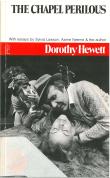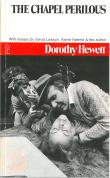Written in Hewett's freewheeling epic style, The Chapel Perilous is a journey play that spans the period between the 1930s and the late 1960s. The story concerns Sally Banner, an over-reacher who attempts to find fulfilment – whether through her gift of poetic expression, through her sexual relationships, or in later years through political activism - and ultimately finds it through self-acceptance. Thematically the play contains the qualities and concerns which are often associated with Hewett's style – female sexuality, questioning of authority and morality, and anarchic tendencies towards structure in both dramatic text and social attitudes.
As Hewett remarks in her 1979 Hecate article: 'Sally is balanced by several symbolic female figures, the "Authority figures" of Headmistress, Anglican teaching "sister", and mother... [along with the] lesbian love figure, Judith, who stands for intellectual control and denial of sensual love' ('Creating Heroines in Australian Plays', p. 77).
 1927062365637770300.jpg
1927062365637770300.jpg
 The Chapel Perilous, Or, The Perilous Adventures of Sally Banner
single work
-
Prologue and two acts
The Chapel Perilous, Or, The Perilous Adventures of Sally Banner
single work
-
Prologue and two acts




